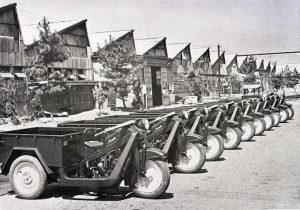Documenting Hiroshima of 1945: In December, production of three-wheel trucks resumes
Dec. 21, 2024
by Maho Yamamoto, Staff Writer
In December 1945, Toyo Kogyo (present-day Mazda Motor Corporation), located in the town of Fuchu-cho in Hiroshima Prefecture around five kilometers from the hypocenter, resumed production of its three-wheel trucks. Despite a shortage of materials, the company managed to complete the production of 10 vehicles by gathering parts from both inside and outside the company.
Toyo Kogyo had lost 119 of its employees in the atomic bombing, including those who had been engaged in the work of building demolition to create firebreaks inside Hiroshima. Although the company’s factory was only partially damaged, production had come to a complete halt. Since right after the bombing, the company had leased its buildings to the prefectural government and media organizations, based on their requests for space.
Meanwhile, one month after the bombing, a group that included Tsuneji Matsuda, who would later become the company’s president and who died in 1970 at the age of 74, began visiting factories in such places as Kurume City in Fukuoka Prefecture to gather materials for production. During the war, the company had manufactured rifles and motorcycles with side cars for use by the military. In Matsuda Tetsuji Tsuisoroku (in English, ‘Memoir of Tsuneji Matsuda’), published in 1972, Mr. Matsuda wrote that, “We were quick to switch to civilian demand, deciding to once again focus on three-wheel trucks for recovery of the business.”
The three-wheel truck, first placed on the market in 1931, was the first vehicle that Toyo Kogyo produced. Most of the other manufacturers that entered the three-wheel truck market at that time relied on imported parts for most of their components. But Toyo Kogyo was determined to use all domestically produced parts, starting with engines, in anticipation that the three-wheel truck would become the main means for cargo transport.
The “GA” model, production of which resumed after the atomic bombing, was on the market from 1938 to 1949. Former president Kenichi Yamamoto, who died in 2017 at the age of 95, joined the company in February 1946, and in a 2005 interview with the Chugoku Shimbun, he said, “The trucks were sold as soon as they were produced. Everyone had the spirit and energy to contribute to the recovery of Hiroshima.”
Vehicles became an essential tool for the transport of cargo, and the three-wheel trucks supported the distribution needed for Hiroshima’s recovery. Production volume of the trucks gradually increased, reaching 2,430 units in 1947, marking the company’s ascent as the top manufacturer in the three-wheel truck industry.
(Originally published on December 21, 2024)
In December 1945, Toyo Kogyo (present-day Mazda Motor Corporation), located in the town of Fuchu-cho in Hiroshima Prefecture around five kilometers from the hypocenter, resumed production of its three-wheel trucks. Despite a shortage of materials, the company managed to complete the production of 10 vehicles by gathering parts from both inside and outside the company.
Toyo Kogyo had lost 119 of its employees in the atomic bombing, including those who had been engaged in the work of building demolition to create firebreaks inside Hiroshima. Although the company’s factory was only partially damaged, production had come to a complete halt. Since right after the bombing, the company had leased its buildings to the prefectural government and media organizations, based on their requests for space.
Meanwhile, one month after the bombing, a group that included Tsuneji Matsuda, who would later become the company’s president and who died in 1970 at the age of 74, began visiting factories in such places as Kurume City in Fukuoka Prefecture to gather materials for production. During the war, the company had manufactured rifles and motorcycles with side cars for use by the military. In Matsuda Tetsuji Tsuisoroku (in English, ‘Memoir of Tsuneji Matsuda’), published in 1972, Mr. Matsuda wrote that, “We were quick to switch to civilian demand, deciding to once again focus on three-wheel trucks for recovery of the business.”
The three-wheel truck, first placed on the market in 1931, was the first vehicle that Toyo Kogyo produced. Most of the other manufacturers that entered the three-wheel truck market at that time relied on imported parts for most of their components. But Toyo Kogyo was determined to use all domestically produced parts, starting with engines, in anticipation that the three-wheel truck would become the main means for cargo transport.
The “GA” model, production of which resumed after the atomic bombing, was on the market from 1938 to 1949. Former president Kenichi Yamamoto, who died in 2017 at the age of 95, joined the company in February 1946, and in a 2005 interview with the Chugoku Shimbun, he said, “The trucks were sold as soon as they were produced. Everyone had the spirit and energy to contribute to the recovery of Hiroshima.”
Vehicles became an essential tool for the transport of cargo, and the three-wheel trucks supported the distribution needed for Hiroshima’s recovery. Production volume of the trucks gradually increased, reaching 2,430 units in 1947, marking the company’s ascent as the top manufacturer in the three-wheel truck industry.
(Originally published on December 21, 2024)








